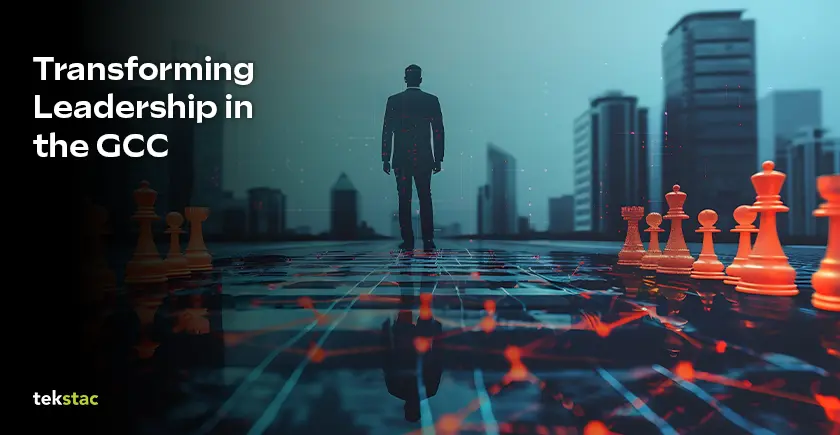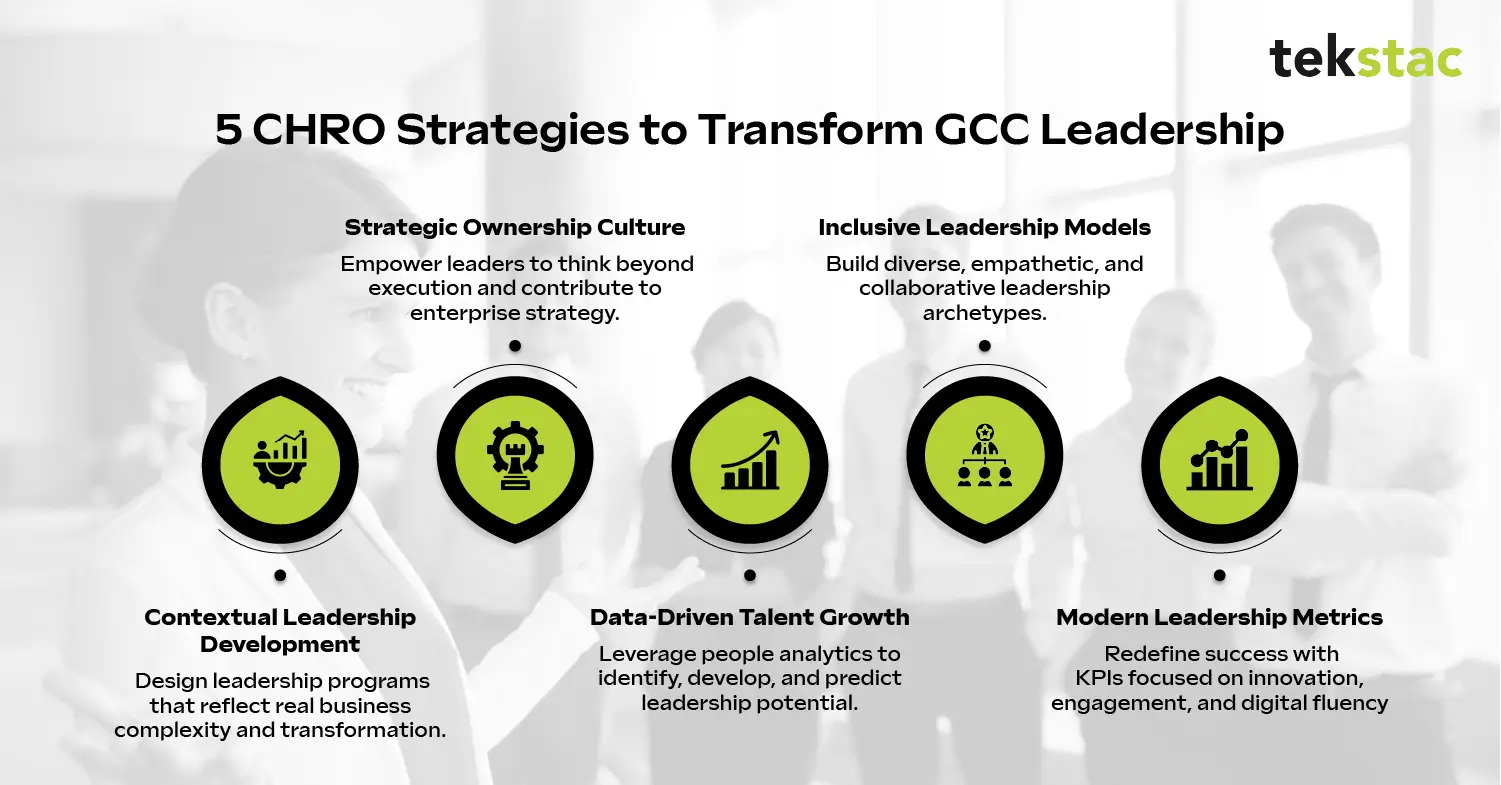Leadership Transformation in the GCC: CHRO Insights on Shaping the Future
July 10, 2025

Leadership Transformation Isn’t Optional — It’s Survival
What happens when cost centers start becoming innovation hubs? When your “support team” begins leading global digital strategy? That’s the story of Global Capability Centers (GCCs) today.
GCCs are no longer back-end operations units- they are emerging as value creators, growth accelerators, and centers of leadership innovation. But while their role has evolved, many leadership styles within them have not. And that’s the bottleneck.
“You can’t power the future with a leadership model built for the past“.
This is where the CHRO must step in, not just as an HR function head but as a transformation architect. One who doesn’t merely manage talent but champions transforming leadership re-engineering mindsets to drive performance, agility, and innovation.
GCCs: From Cost Centers to Competitive Differentiators
The scale and sophistication of GCCs are growing rapidly. India, for instance, now houses over 1,580 GCCs employing more than 1.66 million professionals (NASSCOM, 2024). McKinsey observes the “10/30/50 approach”: 10% of enterprise leaders, 30% of global talent, and 50% of new-age skills now sit in GCCs- signaling their shift from support arms to innovation powerhouses.
This evolution demands a mastery of leadership skills—shifting focus from managing processes to managing outcomes, from task execution to strategic thinking, and from local efficiencies to global collaboration.
Leadership- more than technology- is the defining factor in this transformation.
Why Is Mindset Central to Modern Leadership Transformation?
Most organizations invest in tools and processes when they want transformation. But the most underutilized lever of change is also the most powerful: mindset.
GCC leadership often lags in this area. Built in traditional operational models, leaders tend to exhibit behaviors that are risk-averse, delivery-focused, and hierarchical. This doesn’t fit today’s environment that thrives on innovation, agility, and digital thinking.
A 2024 Deloitte Human Capital Trends report reveals that only 21% of GCC leaders feel prepared to lead in a digital-first, innovation-driven world
CHROs must be deliberate in shifting these deep-seated beliefs and behaviors, and that starts with reimagining how leadership is defined, developed, and deployed in the GCC context.
Top 5 CHRO Strategies to Transform Leadership in GCCs
Leadership transformation in GCCs requires deliberate, multidimensional interventions. Here’s a deeper dive into five strategic levers CHROs must pull to lead this change effectively.

1. Leadership Development That Mirrors Business Transformation
The problem: Most leadership development programs within GCCs are standardized, generic, and often imported from global HQs without contextual relevance. These programs fail to address the unique blend of operational, cultural, and innovation demands that GCC leaders face.
CHRO solution: Redesign leadership development to mirror real-time enterprise goals. Leaders must experience challenges that are ambiguous, complex, and cross-functional, just like the world they operate in.
Key components:
- Simulation-based assessments: Use real-life case studies from within the business to evaluate decision-making under pressure. These go beyond theory and test practical leadership acumen.
- Leadership labs: Assign business transformation problems to emerging leaders and give them autonomy, budget, and a timeline to solve them, like internal start-ups.
- Reverse mentoring: Pair digital-native Gen Z employees with senior leaders. This not only upskills leaders on tech but also fosters humility, openness, and modern communication practices.
- Shadow boards: Allow high-potential leaders to participate in executive decision-making processes to build their strategic thinking muscle.
End goal: Leaders don’t just learn- they transform how they think, lead, and solve.
2. Break the “Order-Taker” Culture, Enable Strategic Thinking
The problem: Many GCC leaders still operate in a “tell me what to do” culture. They focus on executing HQ directives instead of questioning, innovating, or suggesting strategic improvements. This restricts the GCC’s potential to lead value creation.
CHRO solution: Empower leaders to own strategy, not just execution. This involves fostering a mindset shift from servitude to stewardship.
How to implement:
- Training on business acumen: Leaders should be trained to understand enterprise-wide priorities, customer needs, market dynamics, and digital disruption.
- Freedom to fail: Build systems where intelligent failure is seen as a learning process, not a career risk.
- Reimagined KPIs: Move beyond service-level agreements and embed innovation metrics like “value delivered,” “problem-solving impact,” or “enterprise enablement score.”
- Innovation charters: Give each leader a mandate to drive one innovation initiative per quarter, no matter how small.
End goal: Leaders begin to act like entrepreneurs inside the enterprise—thinking bigger, faster, and beyond boundaries.
3. Power Transformation with People Analytics
The problem: Leadership identification and growth are often subjective. Promotions are based on tenure, visibility, or “who you know,” rather than data-backed potential. This blocks real talent from emerging.
CHRO solution: Use people analytics to make leadership transformation measurable, personalized, and predictive.
Tactics:
- 360° feedback analytics: Aggregate data from peers, reports, and managers to identify leadership behaviors that enable or derail team success.
- Leadership potential dashboards: Use predictive analytics to map future-ready traits such as resilience, curiosity, collaboration, and digital fluency.
- Attrition risk tracking: Identify where toxic leadership styles may be contributing to burnout or exit risks and intervene with targeted coaching.
- Customized development journeys: Tailor L&D modules to address the specific behavior or mindset gaps in each leader using data insights.
Example: A GCC in the healthcare tech sector used behavioral analytics to identify that 65% of its mid-level leaders struggled with ambiguity. They rolled out a “Leading in Uncertainty” track, resulting in better decision-making speed during project pivots.
End goal: Talent decisions are no longer based on intuition- they’re based on intelligent, predictive, and personalized data.
4. Design Inclusive, Future-Ready Leadership Archetypes
The problem: Many existing leadership models are still built on outdated ideals- assertiveness, dominance, and output over empathy, inclusion, and long-term impact. This makes leadership homogeneous and limits innovation.
CHRO solution: Build inclusive leadership archetypes rooted in modern behaviors- collaboration, adaptability, authenticity, and empathy. These models must reflect the diverse, global, and hybrid nature of today’s GCCs.
Steps to drive inclusivity:
- Inclusive behavior indicators: Add tangible inclusion metrics to leadership evaluations. For example, “Mentored 2+ team members from diverse backgrounds,” or “Created an environment of psychological safety.”
- Sponsorship over mentorship: Push senior leaders to sponsor high-potential talent from underrepresented groups- actively creating opportunities, not just advice.
- Bias interrupters in decision-making: Train leaders to recognize and override bias during hiring, promotions, and team building.
- Leadership diversity dashboards: Make DEI progress visible across levels. Include metrics on representation, engagement, and advancement.
Some advanced GCCs are now using AI-based sentiment analysis tools to assess inclusion in everyday communication- emails, meetings, and feedback sessions.
End goal: Leaders become magnets for diverse talent and create spaces where all voices are heard, valued, and leveraged.
5. Redefine Leadership Success Metrics
The problem: Too often, leadership success is measured by outdated metrics: output volume, team size, budget managed, or on-time delivery. These miss the essence of transformational leadership.
CHRO solution: Redefine leadership KPIs to align with enterprise innovation, human impact, and future readiness.
Modern leadership metrics may include:
- Innovation velocity: Number of new ideas initiated, tested, and implemented by the leader’s team
- Psychological safety score: Derived from team feedback tools like CultureAmp or Glint
- Cross-team collaboration index: Measuring effectiveness in leading across boundaries and silos
- Engagement uplift post-transition: Comparing team engagement scores before and after leadership change
- Digital quotient score (DQ): A composite measure of tech fluency, adoption rate of digital tools, and enablement of digital transformation initiatives
A US-based retail GCC shifted from individual performance ratings to team-based leadership effectiveness ratings, directly linked to team innovation output and engagement.
End goal: Leadership success becomes about what value you create, not what title you hold.
The CHRO’s Role: From HR Head to Strategic Co-Pilot
The CHRO is no longer responsible just for culture fit- they are responsible for culture shift.
This includes:
- Leading organizational design for agility
- Creating leadership feedback loops across levels
- Building transformation KPIs into scorecards
- Sitting at the table where enterprise change is discussed- not as an observer, but as a driver
When CHROs lead mindset transformation at the top, the ripple effect is enterprise-wide.
Case in Point: Leadership Transformation in Action
A leading European banking GCC based in Bangalore recently transformed its leadership layer through a CHRO-led initiative called “Leadershift.” The program combined reverse mentoring, agile team rotations, leadership “lab” projects, and analytics-backed coaching.
Results in 12 months:
- 37% increase in employee trust in leadership
- 21% faster cycle time for new digital product launches
- 2x increase in internal mobility across teams
This proves that leadership transformation is not theoretical, it delivers measurable ROI.
The Road Ahead: Building Leadership Resilience in GCCs
The future is not going to be stable- it will be volatile, complex, and boundaryless. Leadership models need to reflect that.
By 2027, over 60% of GCCs will own end-to-end digital product portfolios, requiring leaders who can collaborate across time zones, cultures, and technologies (Bain & Company, GCC Outlook 2024).
This means that future-ready GCC leadership will be:
- Resilient under ambiguity
- Digitally fluent, not just digitally aware
- Inclusive by design
- Outcome-focused, not task-oriented
- Capable of creating a learning culture, not just managing one
The CHRO’s influence is central to shaping this profile.
Transforming Leadership Is the Real Digital Strategy
We often talk about digital transformation, but without leadership transformation, it’s just automation. GCCs need leaders who can unlock exponential value, not just optimize processes.
The time is now for CHROs to:
- Challenge outdated leadership norms
- Drive cultural rewiring
- Build innovation-ready mindsets
- Make leadership transformation a strategic priority
Because at the heart of every great GCC is not just great talent or great tech, but transformational leadership that turns ambition into impact.





